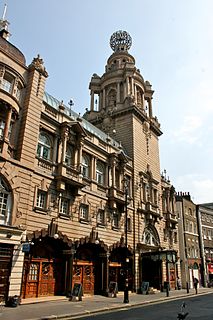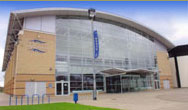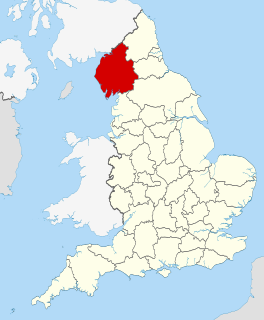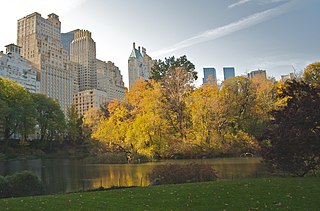
The Royal Opera House (ROH) is an opera house and major performing arts venue in Covent Garden, central London. The large building is often referred to as simply "Covent Garden", after a previous use of the site of the opera house's original construction in 1732. It is the home of The Royal Opera, The Royal Ballet, and the Orchestra of the Royal Opera House. Originally called the Theatre Royal, it served primarily as a playhouse for the first hundred years of its history. In 1734, the first ballet was presented. A year later, Handel's first season of operas began. Many of his operas and oratorios were specifically written for Covent Garden and had their premieres there.

The London Coliseum is a theatre in St Martin's Lane, Westminster, built as one of London's largest and most luxurious "family" variety theatres. Opened on 24 December 1904 as the London Coliseum Theatre of Varieties, it was designed by the theatrical architect Frank Matcham for the impresario Oswald Stoll. Their ambition was to build the largest and finest music hall, described as the "people's palace of entertainment" of its age.
The Ellie Caulkins Opera House, which opened on September 10, 2005, is located in Denver, Colorado as part of the large Denver Performing Arts Complex. It seats 2,225. The Caulkins family pledged $7 million towards the enhancement of the lyric opera house and adjacent public spaces which were constructed inside of the Newton Auditorium.

Grand Théâtre de Genève is an opera house in Geneva, Switzerland.

The Victoria Theatre is a heritage-listed former theatre at 8-10 Perkins Street, Newcastle, City of Newcastle, New South Wales, Australia. It was opened in 1876 and rebuilt during 1890-91, and is the oldest theatre still standing in New South Wales. It was added to the New South Wales State Heritage Register on 27 August 1999.

The Tivoli Theatre, is a theatre in Aberdeen, Scotland, opened in 1872 as Her Majesty's Theatre and was built by the Aberdeen Theatre and Opera House Company Ltd, under architects James Matthews of Aberdeen and Charles J. Phipps, a London-based architect brought in to consult. The auditorium was rebuilt in 1897 by theatre architect Frank Matcham, but then closed temporarily in 1906, following the opening of the larger His Majesty's Theatre. The smaller theatre was extensively reconstructed in 1909, again by Frank Matcham, and re-opened in July 1910 as the Tivoli. The Tivoli was refurbished again in 1938.

Grimsby Auditorium is a theatre situated on Cromwell Road, in Grimsby, North East Lincolnshire. With a seated audience capacity of 1,200 the Grimsby Auditorium is the largest professional theatre in Lincolnshire, and one of the larger theatres in the East of England. Built in 1995, it is managed by the venues division of Ambassador Theatre Group on behalf of North East Lincolnshire Council.

The Opera House in Quay Street, Manchester, England, is a 1,920-seater commercial touring theatre that plays host to touring musicals, ballet, concerts and a Christmas pantomime. It is a Grade II listed building. The Opera House is one of the main theatres in Manchester, England. The Opera House and its sister theatre the Palace Theatre, Manchester on Oxford Street are operated by the same parent company, Ambassador Theatre Group.

The Royal Wanganui Opera House is New Zealand's last Victorian theatre. Located in St Hill Street in central Wanganui, the 110-year-old theatre seats 830 and is the venue for many local, national and international events.

The Liverpool Olympia is a venue in Liverpool, England, situated on West Derby Road next to The Grafton Ballroom.

The King's Theatre was opened in 1906 and stands on a prominent site on Leven Street in Edinburgh. It is one of Scotland's historic and important theatres.
The Regent Cinema was a cinema in Brighton, England. It was opened by Provincial Cinematograph Theatres on 27 July 1921 and was one of that company's first super cinemas. It was demolished in 1974.

The Tyne Theatre and Opera House is a theatre in Newcastle upon Tyne, England. It is a Grade I listed building[1], rated "in the top 4% of listed buildings" by English Heritage and is afforded a three star rating by the Theatres Trust, "a very fine theatre of the highest theatrical and architectural quality". It opened in 1867 as the Tyne Theatre and Opera House, designed by the Newcastle upon Tyne architecture practice of William Parnell. The backstage area was damaged by fire in 1985, with subsequent rebuilding restoring the Victorian stage machinery.

The Ashcroft Theatre is a theatre located within the Fairfield Halls, Croydon, South London. The theatre was named after Croydon-born Dame Peggy Ashcroft and is a proscenium theatre with a stepped auditorium. The mural on its fire curtain is by the artist Henry Bird. A variety of productions are held throughout the year such as drama, ballet, opera and pantomime. The venue has a seating capacity of 763 and can be converted into a cinema as it has a large screen giving full Cinemascope and standard film format.

Brighton Hippodrome is an entertainment venue in the ancient centre of Brighton, part of the English city of Brighton and Hove. It has been empty and out of use since 2007, when its use as a bingo hall ceased.
Aberdeen has been the host of several theatres and concert halls through history. Some of them have been converted or destroyed over the years.

The Opera House is a former opera house and current pub in Royal Tunbridge Wells, Kent, England. It is also a Grade II listed building.
The Theatre Royal, Hanley was a theatre in Stoke-on-Trent, England with a long history.




























